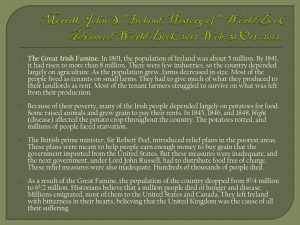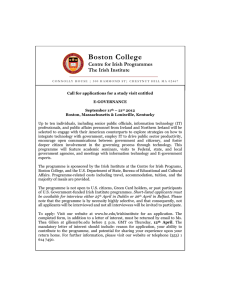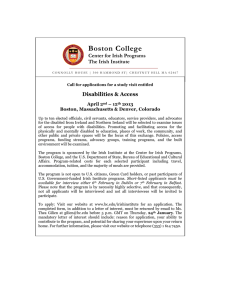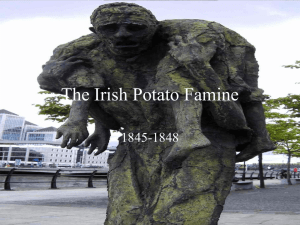The Irish Immigrant Experience and the Potato Famine: Ireland, 1845-49
advertisement
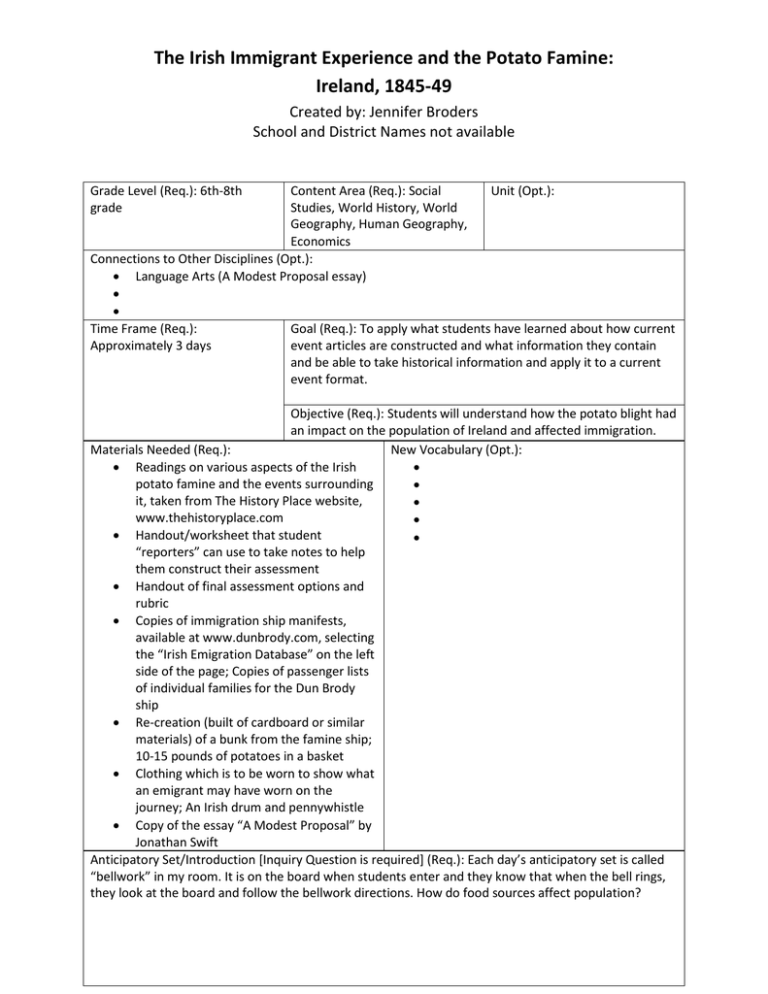
The Irish Immigrant Experience and the Potato Famine: Ireland, 1845-49 Created by: Jennifer Broders School and District Names not available Grade Level (Req.): 6th-8th grade Content Area (Req.): Social Unit (Opt.): Studies, World History, World Geography, Human Geography, Economics Connections to Other Disciplines (Opt.): • Language Arts (A Modest Proposal essay) • • Time Frame (Req.): Goal (Req.): To apply what students have learned about how current Approximately 3 days event articles are constructed and what information they contain and be able to take historical information and apply it to a current event format. Objective (Req.): Students will understand how the potato blight had an impact on the population of Ireland and affected immigration. Materials Needed (Req.): New Vocabulary (Opt.): • Readings on various aspects of the Irish • potato famine and the events surrounding • it, taken from The History Place website, • www.thehistoryplace.com • • Handout/worksheet that student • “reporters” can use to take notes to help them construct their assessment • Handout of final assessment options and rubric • Copies of immigration ship manifests, available at www.dunbrody.com, selecting the “Irish Emigration Database” on the left side of the page; Copies of passenger lists of individual families for the Dun Brody ship • Re-creation (built of cardboard or similar materials) of a bunk from the famine ship; 10-15 pounds of potatoes in a basket • Clothing which is to be worn to show what an emigrant may have worn on the journey; An Irish drum and pennywhistle • Copy of the essay “A Modest Proposal” by Jonathan Swift Anticipatory Set/Introduction [Inquiry Question is required] (Req.): Each day’s anticipatory set is called “bellwork” in my room. It is on the board when students enter and they know that when the bell rings, they look at the board and follow the bellwork directions. How do food sources affect population? Instructional Sequence/Procedure (Req.): 1. Day 1: Bellwork: In your journal, answer the following questions: What is “history”? Make a list of anything you would consider to fall into this category. (up to 5 items) What kinds of events that we look at in our current event discussions are “history”? What does it take to make something a current event, and what makes it become part of history? 2. Have students complete the bellwork on the board. Give them 3-5 minutes to respond, and then discuss their responses. See what questions might be generated. 3. Explain to students that we are going to take a current event-style approach to an historical event. They will get a handout explaining that they are reporters for the New York Times and are able to take a time machine back to the Ireland of the late 1840s to research why so many Irish emigrated from their home country. This lesson will be taught during second semester, and students will already be familiar with reading and writing in relation to current event news articles. This will be a chance to read, look and listen in order to write about what they have learned. The final writing will be their assessment for this unit. 4. Students will be divided into five mixed-ability groups for this portion of the activity. Each student will have a packet with the first page an explanation of the unit and the assignment and the second page a list of assignment options and a grading rubric. Go over the assignment with each class to make sure they understand what is expected. 5. Each group will be given a reading on some aspect of the Irish Potato Famine and will take turns reading aloud and then answer the questions as they encounter them in the reading. After all groups have finished reading and compiling their answers, we will come back as a large group. 6. Beginning with the “Introduction” group, each group will take center stage as they teach the other groups what they learned. They will also convey answers that will be used by other groups to complete their reporters’ notes. 7. If any time remains, students may ask questions of other groups, or there may be a general discussion of the Potato Famine. 8. Day 2: Bellwork: Please get our your reporters notes from yesterday and prepare to meet our speaker for today, an Irish woman who has booked passage on the Dun Brody ship from the city of New Ross in Western Ireland. Have a pen or pencil ready and please give our guest your respectful courtesy. 9. During the class today, I will be performing a first-person performance of an Irish woman who sailed on the Dun Brody famine ship. This is based on one I saw when I visited the Dun Brody in Ireland. At the end, I will also make note that today there are 40 million Americans of Irish descent and that today the number one source of income in Ireland is from tourism, and many of those tourist dollars come from Americans, of Irish heritage or no, who want to understand and visit one of the most beautiful countries in the world. The popularity of shows such as Riverdance have created a great interest in Irish culture around the world. 10. (Note: This, obviously would be optional – if someone wanted to just talk about what it was like on a famine ship, that information could be obtained at the museum’s website, www.dunbrody.com) 11. As I give my talk, students will see what 10-15 pounds of potatoes looks like, will find out facts about the voyage and about tenant evictions (to be evicted meant the roof of your thatched cottage was set on fire so you could not possibly live in the house) and demonstrate an Irish drum and pennywhistle. This is one way to talk to kids about how cultures change (immigration), but also how people may have multiple cultural identities (Irish Americans). 12. I will also explain how the satirist Jonathan Swift wrote an essay entitled “A Modest Proposal” which advocated that if the Irish were starving, they ought to eat their own children. Swift, who was actually the Dean at St. Patrick’s Cathedral in Dublin, and an Irishman, was satirizing the fact that the British were doing nothing while the Irish starved to death. If the instructor feels that students could understand the concept of satire in relation to the information they have just read about the famine and the British response to same, one might consider showing the essay to students, or may even talk to a language arts teacher about looking at the essay in that venue instead. 13. There will also be a Q & A following my talk, and a discussion of how the information I give during my talk dovetails with the information they have in their notes. 14. Day 3: Bellwork: Please get out your reporters notes to prepare for a workday on the assignment. Also, think about the following questions: how did the first-person performance yesterday reinforce what you learned in your notes? Did you learn something new that surprised you? How did hearing the story of an individual impact your learning? 15. Today is designed to be a work day on the assignments. Students will start out discussing their assignment choice with a table partner and then begin work. I wanted to make myself available to them, and to make the readings available in case students had further questions or wanted to add more information. 16. 17. 18. 19. 20. Formative Evaluation (Req.): During discussion and Assessment (Req.): A written form of a current as students are answering questions based on the event, with three options available as well as a reading. In addition, during student work time on rubric so students will know how the assessment the final assignment, I will be talking with students will be evaluated. about what options they have chosen and I will do some review as they work to guide them if they do not understand something. Iowa Core Curriculum Standards Used (Req.): • Behavioral Sciences, grade 6-8: Understand the changing nature of society. • Economics, grade 6-8: Understand the role of scarcity and economic trade-offs and how economic conditions impact people’s lives. • Economics, grade 6-8: Understand how governments throughout the world influence economic behavior. • Geography, grade 6-8: Understand how human factors and the distribution of resources affect the development of society and the movement of populations. • History, grade 6-8: Understand cause and effect relationships and other historical thinking skills in order to interpret events and issues. • • • • • Common Core Curriculum Standards Used (Opt.): • • • • • NGS Standards Used (Req.): • The characteristics, distribution, and migration of human population on Earth’s surface • • • • • • • • • Five Themes of Geography Used (Req.): • Place • Human-Environmental Interaction • Movement • • 21st Century Universal Constructs (Opt.): Other Disciplinary Standards (Opt.): • • • • • Other Essential Information (Opt.): Other Resources (Opt.): • • • • School District Standards and Benchmarks (Opt.): • • • Potato Famine Assignment and Notes – p. 1 News Story Assignment: The Irish Potato Famine Due Date: ______________________ You are a news reporter for the New York Times. This is your chance to make it big in the newspaper business because you are going to be the first reporter to use a time machine to go to Ireland in 1849 to see firsthand what the Irish Potato Famine was all about. You will be able to read present day information about various aspects of the Great Hunger, as it was known. Then you will travel back in time and meet a woman who is travelling with her family from their home in western Ireland to a new life in North America. You will see what the ship may have looked like and take notes on what you see and hear. You will also see information about other families on the ship, as well as look at documents for other ships. Remember, as a reporter, you job is to start with the following questions: Who (Who is involved in this story?) What (What has happened to cause people to leave their homes?) When (What year/s is this happening?) Where (From where are they leaving, and to where are they hoping to go?) Why (Why did the famine happen? Why did the people have to leave? Why didn’t the government help them?) This sheet is the first page of a packet including your assignment details, assignment options and rubric, and the notes you will need to report on your story. Specific directions on what to do for your notes can be found on page 3. This packet is where you will keep your notes, so be careful not to lose it. Also, remember to take notes of what you hear and see when you visit the Dun Brody famine ship. What things strike you as unusual? Does anything seem frightening? Would you want to travel on this ship? Why/why not? Are there any dates, people or places mentioned? Does she refer to anything you may have seen in your reading? Think about these questions as you listen to the emigrant woman. What will you be expected to turn in? After you have taken your notes, you will put together a current event news story in some form (see p. 2 for options). Remember to include the who, what, when, where, why aspects, with details for each. The rubric will tell you specifically how your writing will be graded. All source information/reading documents will be available in the classroom for reference as well as on my web page, so you may work outside of class as well if necessary. But if you take good notes, you should not need anything further. Potato Famine Assignment and Notes – p. 2 News Story Assignment: The Irish Potato Famine Final Assessment Options and Rubric For this assessment, you have gathered information about the Irish Potato Famine. Select one of the following options. #1 Traditional news story - It should be between 250-500 words. It should follow a general news story format, keeping strictly to the facts (who, what, when, where, why), giving enough detail to help readers understand the issue. #2 Emigrant Diary - You are now a native of Ireland having to leave your country. Tell us the who, what, when, where, and why, but do it from the perspective of someone who has been forced to leave his or her home because of the Potato Famine. Should be 250500 words. #3 Graphic novelization – Using the who, what, when, where, and why, use a graphic novel format, creating illustrations and characters who tell us the story of the who, what, when, where, and why of the Potato Famine. Length may vary. Use as many panels as necessary to convey the issue. Grading Rubric Assessments will be graded with the criteria below Who – 5 pts What – 5 pts Where – 5 pts When – 5 pts Why – 5 pts Final product makes sense and explains the issue – 5 pts Correct spelling – 5 pts Correct grammar – 5 pts Total points – 40 Date due: _________________________ Potato Famine Assignment and Notes – p. 3 Irish Potato Famine – Reporter Information Packet Each group will read one article and answers questions about it. Following the completion of questions, groups will then share the information they gathered by teaching the rest of the class about the article and give them answers to fill in their own packets. By the time each group is finished, all reporters should have the same information to work with. You will turn this packet in at the end of the unit for credit. Article: Introduction 1. How many people died or left Ireland from 1845-51? 2. What were living conditions like for 50% of the poor of rural Ireland 3. Who owned the land in Ireland? 4. How much land did tenant farmers live on? 5. What did the Irish mostly depend on for food? 6. By the mid 1800s, what was the population density of Ireland? 7. Where did potatoes come from originally? 8. Why were potatoes so widely grown in Ireland? 9. What variety of potatoes were planted by most Irish and when did they plant them? 10. How many potatoes were consumed each year? 11. What is another fact you learned about in this article that you think others should know? Potato Famine Assignment and Notes – p. 4 Article: Before the Famine 1. Why did the Irish rebel in 1798? 2. What happened in 1800 that abolished Ireland’s 500 year independence? 3. What religion was outlawed? Why? 4. How much of Ireland was Catholic? 5. How did land ownership change from 1600 to 1778? 6. How did the British see the Irish? 7. By 1835, how many Irish were without regular work? 8. Give two examples of treatment received in a workhouse. 9. How many Irish went to America between 1815-1845? 10. Who was Daniel O’Connell? 11. What is another fact you learned about in this article that you think others should know? Potato Famine Assignment and Notes – p. 5 Article: The Blight Begins 1. What caused the potatoes to die? 2. An October 1845 study predicted how much of the crop would rot? 3. What was one “unscientific” theory for the blight? 4. Why did British Prime Minister Peel want to repeal the Corn Laws of 1815? 5. Why didn’t the law get repealed? 6. Why was it bad that Charles Edward Trevelyan was appointed to oversee Irish relief operations? 7. Why didn’t it help when Peel bought two shiploads of maize*? 8. Why was corn not as good to eat as potatoes? 9. What does “laissez-faire” mean? 10. Why did Irish farmers sell wheat, barley and oats instead of keeping them for food? 11. What is another fact you learned about in this article that you think others should know? *maize is what we refer to as corn. In Ireland, when people say “corn” even today, they mean “barleycorn” or what we would call “barley” In the article, maize is sometimes referred to as Indian corn, which is not the same as the multi-colored, decorative (and not terribly edible) corn that we call Indian corn. Potato Famine Assignment and Notes – p. 6 Article: The Great Hunger 1. Why might the resignation of Prime Minister Peel have negative consequences for Ireland? 2. What was Trevelyan’s reason for rejecting Indian corn** for Ireland? 3. What was his plan for the British to do to help the Irish in 1846? 4. List two problems with Trevelyan’s free market plan. 5. What system did the Irish use instead of money? Why do you think they did this? 6. Why was any relief plan requiring the Irish to buy food doomed to fail? 7. Why didn’t they just eat fish? 8. How did Quaker William Forster describe Irish children? 9. Surprisingly, most did not actually die from hunger. What did they die from? 10. What Act, passed in 1847, was meant to finally help? Why didn’t it? 11. What is another fact you learned about in this article that you think others should know? ***maize is what we refer to as corn. In Ireland, when people say “corn” even today, they mean “barleycorn” or what we would call “barley” In the article, maize is sometimes referred to as Indian corn, which is not the same as the multi-colored, decorative (and not terribly edible) corn that we call Indian corn. Potato Famine Assignment and Notes – p. 7 Article: Coffin Ships 1. What was a “coffin ship” and where did they go? 2. Why were so many people sick? 3. How long might it take to see a doctor? 4. What had poor families been told by their Irish landlords? Why did they tell them this? 5. Of the 100,000 Irish who sailed to Canada, how many died? 6. Why did so many Irish men leave Canada for the U.S.? 7. How did the U.S. limit immigration? 8. How much food did emigrants get on board a ship? 9. What happened to those who died on board? 10. Where might the poorest of the poor go if not to North America? 11. What is another fact you learned about in this article that you think others should know? Potato Famine Assignment and Notes – p. 8 Additional Reporter Notes on the Emigrant Speaker If she says anything you may have read about, you may wish to jot it down. Also, make sure to look at the ship’s quarters so you can describe living conditions to your readers. The speaker may also give other information that might be relevant to your story. Listen carefully and ask questions if you have them.





